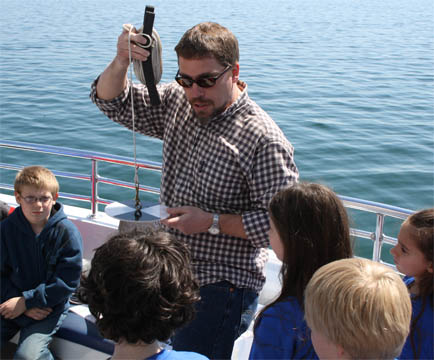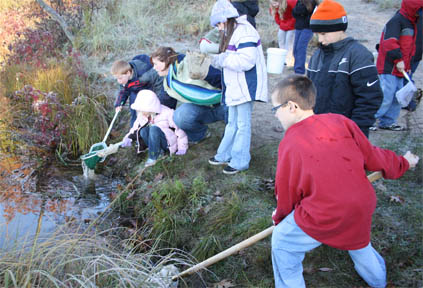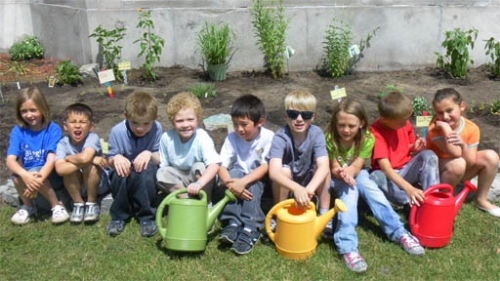Bingham Arts Academy completes rain garden project, learning while benefiting Lake Huron watershed
Teachers and students engage in establishing a schoolyard rain garden, creating an outdoor classroom for themselves and promoting water resource awareness and stewardship education with their community!
It is commonly said that ‘youth are our future’. A schoolyard rain garden project developed by elementary students at Bingham Arts
Academy serves to illustrate that youth are valuable stewardship partners in our communities today. With encouragement and support from their teachers, students at Bingham Arts Academy
explore hands-on, place-based education projects resulting in a growing student culture of conservation
stewardship and awareness of local issues of the Lake Huron community of Alpena, Mich. At the close of the school year, these youth  left their school,
their community, and the environment of Thunder Bay Watershed and Lake Huron a better place – and they learned a great deal in the process!
left their school,
their community, and the environment of Thunder Bay Watershed and Lake Huron a better place – and they learned a great deal in the process!
An initial grant for a school-wide recycling program led to the development of a rain garden and outdoor classroom projects through their Northeast Michigan Great Lakes Stewardship Initiative (NE MI GLSI) partnership. Though this initiative, Bingham students have been working with school educators and community partners in creating a schoolyard rain garden with the goal of helping reduce water pollution in the local Thunder Bay River watershed. The students are featuring plants native to Michigan, inviting natural pollinators to visit the garden. Moreover, Bingham teachers and students hope this schoolyard rain garden will serve as a community model to establish rain gardens and promote responsible stewardship actions.
“Don’t all gardens need rain?” That is the question in anyone’s mind who hears for the first time they will be putting in
a ‘rain garden.’ According to horticulturists
at Michigan State University, rain gardens are a collection of plants that serve as a “living retention and filtering area for storm water that would
otherwise simply run off.” Students involved in this project gain first-hand experience in what it means to conserve our natural resources. According
to 2nd grade teacher, Anne Negro, “My class has a better understanding of why it is important to have the garden, but also why it's
important to get others in the community educated and involved with the garden and our school.” 
A multi-class effort, this project linked first and second graders, together, in learning about storm water run-off, soil composition, sun and shade tolerance, and the local native plants that thrive in these situations. Meeting together for one hour per week, students set off exploring the school grounds identifying how rainwater moves, where it would be absorbed back in the ground, or conversely, how it reacts once it lands on the roof or parking lot. Other elements of the student research included understanding the attraction of pollinators and what makes a plant native to a geographic location. With this research in mind, the students gave presentations to each other and during the school-wide Bingham Go Green Fair. This platform introduced students of all grades (and parents, too) to the garden concept as the first and second graders offered charts, photos and information about the process of making a garden.
In June of 2012, thirty-two students from Bingham Arts Academy, along with teachers and community partners, completed the first phase of their native plant rain garden including colorful hand-made signs
interpreting plants and – of course – a rain gauge. This area will continue to be used to educate following classes on many of the same topics this year’s
classes studied; and more plans on the horizon include a composting station, being listed in a potential city demonstration rain garden brochure,
and continued use for in-school and community education. The hope is to encourage others with limited yard space to consider adding a rain garden or
native plants for the benefit of the local wildlife and watershed.
On a beautiful spring day, the classes were able to follow the path storm water would normally take as they walked from their school to the river to board the Lady Michigan, a glass bottom touring boat in Thunder Bay. The students were able to physically connect their school building to the waters of Lake Huron through an educational boat trip that focused on the Thunder Bay River Watershed and Lake Huron water quality, fisheries, and issues such as aquatic invasive species. The unforgettable experience allowed students to recognize the connections between their land-based stewardship projects and Lake Huron.
For more information about the Northeast Michigan Great Lakes Stewardship (NE MI GLSI) Initiative and place-based, community-based education programming partnerships with Bingham Academy Schools, visit the NE MI GLSI website and Bingham Academy's project page.



 Print
Print Email
Email




